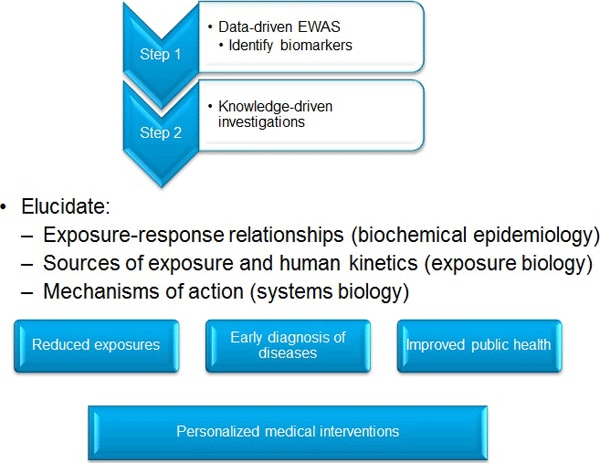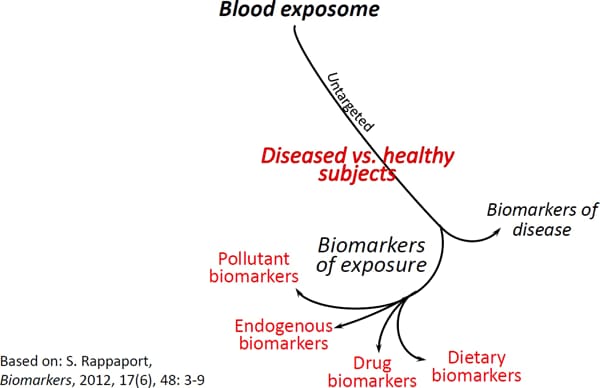Access Agilent eNewsletter July 2015
>> Update My Profile | Subscribe to Access Agilent | Article Directory

Broad-based Agilent solutions make the most
of multi-omics to unravel the exposome
By Anthony Macherone, Ph.D.
Agilent Senior Scientist
Visiting Scientist, Johns Hopkins University School of Medicine
The science of environmental exposure is changing from a single point, bottom-up strategy where you measure one exposure and one effect to a complex discovery approach. It is not straightforward to determine how multiple exposures over a lifetime affect human health, but Agilent analytical instruments and software work in cohort to provide powerful tools that enable this assessment.
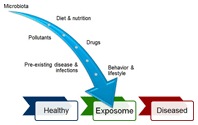 Enlarge
Enlarge
Figure 1. Bioaccumulation of external and internal chemical exposures over an individual’s lifetime increases disease burden.
Exposome encompasses a lifetime of exposures
The exposome paradigm integrates nontargeted techniques to identify relevant biomarkers with a targeted approach to discover and differentiate biomarkers of exposure and disease and to identify causal associations between exposures, genetics, and health status. The exposome represents the totality of exposures from conception onwards.
Unraveling the exposome requires identification, characterization, and quantification of the exogenous and endogenous exposures and modifiable risk factors that predispose a person to diseases throughout his life span. The exposome concept complements the human genome idea; although decoding the human genome increased our understanding of the underlying genetic causes of disease, genomic analysis explained only a part of the disease burden.
Simultaneously consider nature and nurture
Environmental and lifestyle factors are equally or even more important than genetics in determining susceptibility, onset, and exacerbation of human disease. Exposome science promises to provide the conceptual framework to understand the complex web of interactions between genes and environment and their causal association to disease. It provides the impetus to overhaul the nature versus nurture dilemma towards an integrated perspective of human disease that is defined by complex and dynamic interactions between DNA sequence, epigenetic DNA modifications, gene expression, metabolite profiling, and environmental factors that all combine to influence disease phenotypes.
To use the exposome paradigm to decipher the complex interactions that cause or exacerbate human disease, we must assess the connectivity between various risk factors and modifiers at various biological dimensions. This interplay defines human susceptibility to external stressors.
The exposome paradigm motivates studies of nongenetic causes of chronic diseases in much the same manner that a genome-wide association study (GWAS) explores genetic causes. Description of the human exposome requires a wide array of state-of-the-art technologies that span environmental and exposure science and engineering, biochemistry, molecular biology, toxicology, bioinformatics, and epidemiology. These techniques are organized in specific workflows to provide additional insights on the environmental burden of disease.
Agilent supplies a multi-omics platform to study these complex interactions
The Agilent approach to analytical exposure biology is based on a multi-omics platform that includes:
- Whole-genome and targeted transcriptomics using microarray analysis and proteomics.
- Measurement and characterization of the blood exposome through the application of metabolomics workflows that use established and robust sample preparation protocols and the latest generation of instruments. The latter includes ultra-high-performance liquid chromatography (UHPLC), mass spectrometry (MS), gas-phase mass spectrometry, and inductively-coupled plasma mass spectrometry.
We propose a tiered process, as follows:
- Non-hypothesis, data-driven analyses using exposome-wide association studies (EWAS) will differentiate significant chemical features in diseased versus healthy models.
- Once key chemical features are identified, targeted follow-up studies annotate and validate these biomarkers.
- Putative biomarkers are corroborated using additional evidence provided by other -omics technologies (including transcriptomics and proteomics) and epigenetic information.
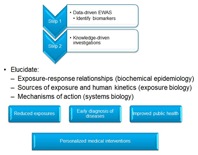 Enlarge
Enlarge
Figure 2. Exposome characterization requires a two-phased approach: first, non-hypothesis-driven discovery to capture as many chemical signatures as possible and second, targeted follow-up studies to validate and annotate putative markers.
We are building an exposure biology model to support the integration of the relevant datasets. The Agilent GeneSpring software suite, including Agilent Mass Profiler Professional, is the main underlying platform we use. This model will provide:
- Elucidation of exposure-response relationships (biochemical epidemiology)
- Identification of sources of exposure and human kinetics (exposure biology)
- Mechanisms of action (systems biology)
Find true disease causes rather than just simple correlations
Exploration of disease causality instead of simple associations with health stressors and risk modifying factors requires mechanistic understanding of all intermediate events related to perturbed homeostasis. Identification of perturbations requires high-throughput data acquisition and interpretation supported by systems biology models and advanced bioinformatics. With these tools, the actual biological and metabolic pathways related to adverse health outcomes can be distinguished from perturbations that are efficiently overcome by inherent defense mechanisms.
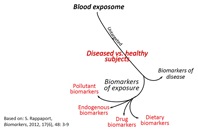 Enlarge
Enlarge
Figure 3. The two-phase analytical approach to characterize and quantify the exposome will allow the differentiation of causative disease factors from downstream biomarkers of disease.
The exposome paradigm opens the way to a totally new era in environmental health science and chemical risk assessment. It brings together high-throughput analytical tools, big data analytics, and biology-inspired modeling to understand the multi-causal associations of complex diseases.
Mass spectrometry and other technologies such as spectroscopy and remote (“smart”) sensors will characterize the exposome in large, prospective cohorts and provide reliable information on exposure-risk relationships. The exposome paradigm will facilitate the translation of applied research into educational, behavioral, and policy-based, risk-mitigating interventions.
The exposome is a complex research area that requires broad-based, sophisticated tools. Agilent provides a wide range of hardware, software, and informatics solutions for this multi-omics research. Learn how Agilent delivers more than just world class systems, software, and supplies – discover a complete set of integrated biology solutions that you can apply to unravel the exposome.
>> Update My Profile | Subscribe to Access Agilent | Article Directory
Figure 1.
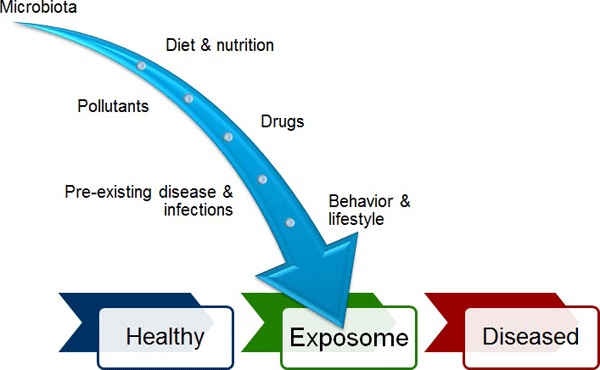
Bioaccumulation of external and internal chemical exposures over an individual’s lifetime increases disease burden.
